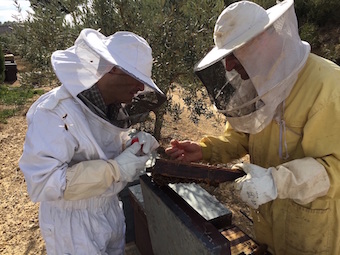
North American, Spanish and German researchers, leaded by Joel González-Cabrera, from the Universitat de València, published yesterday Wednesday in the journal ‘PLOS ONE’ a study which describes two new mutations which allow the mite of the bees ‘Varroa destructor’ to adapt and survive chemical treatments. The work faces one of the biggest problems of the apiculture and agriculture: a mite which decimates bee world population.
The article, ‘Novel mutations in the voltage-gated sodium channel of pyrethroid-resistant Varroa destructor populations from the Southeastern USA’, describes the work done to identify the mutations which make the mite ectoparasites, Varroa destructor, indifferent to pyrethroid, a very effective kind of insecticide to control various species of mites and insect infestation and that have been the treatment chosen by the beekeepers to control the mite during decades.
Some insecticide are specially active against mites, that is why they are known as acaricides. The pyrethroid tau fluvalinate and flumethrin eliminate almost the 100% of the parasites in hives. This compounds act on some proteins called voltage-gated sodium channels (VGSC), which transmit the nerve impulse. The treatment, by acting on the nerve system of Varroa, overstimulates it and causes its death.
In this work, researchers have discovered two new mutations on the genome of the mite, precisely in the key place to the functioning of this acaricide family, the VGSC, which make these acacides don’t joint property to the sodium channel, so it is not affected and the parasite survive to insecticides. The results obtained are clear: the 98% of the mites which survive the treatment are mutants for one or two mutations, identified as L925I and L925M, respectively.
The samples used in this researcher came from various localities of Florida and Georgia, in the United States, even thought in previous works, using the same samples picked in English hives, the researchers had already discovered a different mutation which was located in the same place than the genome of the mite (L925V). This informationhas allow for develop a diagnosis method to determine if the mite can or not survive to the treatment.
Joel González-Cabrera, first signed of the scientists article, currently works in the Structure of Interdisciplinary Research BIOTECMED of the Universitat de València with a contract of the programme Ramón y Cajal. ‘We can develop new filter methods and mitigate the parasite impact. The diagnosis prove analyses in a quick and precise way the individual mites and detects the presence or absence of mutations. If we give this information to the beekeepers, they will have a reliable tool to select the most suitable treatment’, he has highlighted.
The Varroa destructor parasite is spread almost all the world and causes havocs in honeybee populations (Apis mellifera L.) that produces honey and is one of the most effective pollinating agent. The world production of the 10% of food, which means around 150.000 millions of euros, depends on it, according the researcher of the Universitat.
The devastating effect produced by the mite, both by the direct alimentation on immature and adults bees and by the different virus it transmits, destroys parasitical hives in a maximum of three years if there are not efficiency control measures. This effect is currently considered one of the keys of the reduction in bee population in global scale, so, it has connotations both in alimentary and environmental level.
Research career
Joel González-Cabrera works as a researcher in BIOTECMED and in the group of Biotechnological Infestation Control (CBP) of the Universitat de València, allocated to the study of genetics and biochemist bases of the resistance to insecticides to underline the appearance and to avoid the phenomenon of the cross resistance.
The research, which has given rise to the publication of the article in PLOS ONE, started during his post doctoral stay in England, in the Institute Rothamsted Research, reference centre in studies on agriculture with more than 170 working years and which has the strategy financing of the Biotechnology and Biological Sciences Research Council .
Article:
“Novel mutations in the voltage-gated sodium channel of pyrethroid-resistant Varroa destructor populations from the Southeastern USA”. Joel González-Cabrera et al. PLOS ONE, mayo 2016
Link: http://dx.plos.org/10.1371/journal.pone.0155332
Last update: 19 de may de 2016 12:07.
News release


















